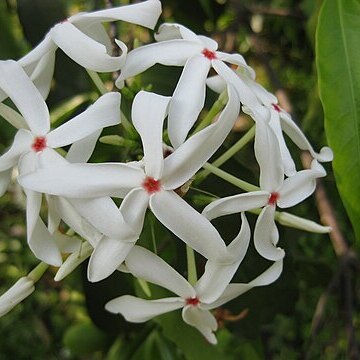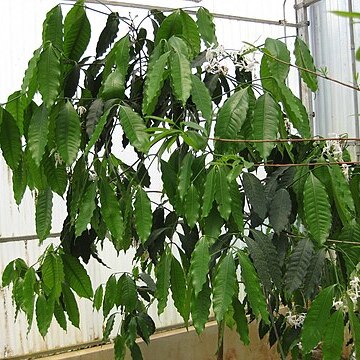Tree to 14 m tall, to 30 cm dbh. Bark grey; inner bark pale brown. Branchlets glabrous or sparsely puberulent when young, sparsely lenticellate or not. Leaves: petiole 3-10 mm long, glabrous; blade subcoriaceous to coriaceous, elliptic, 4.5-30.5 by 1.4-12 cm, 1.9-5.7 times as long as wide, apex caudate to acuminate with a blunt tip, base acute or cuneate, glabrous above and beneath, secondary veins 9-18 pairs with 4-13 mm spacing, 60-65° from midrib. Inflorescence dichasial, 4.8-15.3 cm long with axes 2-12.5 cm long and branches 1.2-2.7 mm wide, glabrous to sparsely puberulent; peduncle 0.7-8.1 cm by 2.1-2.7 mm, glabrous or puberulent in upper parts; pedicels 0-5 mm long, glabrous to densely puberulent. Sepals ovate, narrowly ovate or oblong, 1.8-6.3 by 0.6-1.9 mm, 1-3.7 times as long as wide, apex obtuse to acute, ciliate, glabrous to sparsely puberulent outside, glabrous or puberulent on upper half inside. Corolla completely white; tube 20.5-35 by 1.6-2.2 mm, 1.3-2.7 times as long as lobes, 5.4-13.6 times as long as calyx, glabrous to sparsely pubescent around stamens and slightly beneath inside, glabrous or sparsely puberulent at top of tube outside; lobes 7-21.5 by 3.4-6.5 mm, 1.6-4.4 times as long as wide, elliptic or oblong, apex rounded to obtuse, ciliate or ciliate only at lobe base, inside glabrous or sparsely pubescent in upper quarter, outside glabrous. Stamens inserted 18-32.3 mm from corolla base which is 0.8-0.9 of corolla tube length in rehydrated flowers; anthers 1.2-1.7 by 0.5-0.8 mm, apex 0.1-1.4 mm from corolla throat; filaments 0.8-1.2 mm long. Disk 0.7-2.1 mm long, 1.1-1.9 times as long as ovaries, glabrous, oblong, hourglass-shaped, or awl-shaped, apex shape variable and often quite complex ranging from simply acuminate to rounded to horizontally V-shaped and flat on top or horizontally V-shaped and retuse on top. Ovaries 0.9-1.2 mm high, glabrous to sparsely pubescent all over; style 18-25 mm long; style head 0.8-1.1 mm long. Fruit oblique ellipsoid or subglobose, blue-black, 14-42.4 by 5.5-15.5 by 8-22 mm, only one carpel developing, spur absent, glabrous.
More
Trees to 15 m tall. Branches greenish, terete, slightly compressed, puberulent when young. Petiole 5-15 cm; leaf blade elliptic, narrowly elliptic, or narrowly ovate, 8-24 X 3.5-8.5 cm, glabrous, apex acute or short acuminate; lateral veins 10-20 pairs. Cymes corymbose, many flowered; peduncle to 14 cm, puberulent or glabrous; bracteoles narrowly oblong, puberulent or glabrous. Pedicel 3-4 mm. Sepals narrowly oblong, 4-6 mm, puberulent or glabrous. Corolla white, tube ca. 2.5 cm; lobes narrowly oblong, 1.5-2 cm. Disc scales narrowly oblong, longer than ovary, fleshy. Ovary ovoid, puberulent. Drupes black or blue-black, ellipsoid, 2.5-3.5 X 1.5-2 cm. Fl. Apr-Sep, fr. Jul-Dec. 2n = 72.
Shrub or small tree to 8 m high. Leaves with petiole 9–15 mm long; lamina lanceolate-elliptic, narrowly elliptic to elliptic, to 20 cm long, to 8 cm wide, cuneate, acute to shortly acuminate, discolorous, dark glossy green above, pale green below; secondary veins 13–15 each side of midrib, obscure above; tertiary venation reticulate. Flowers 30–32 mm long, 24–32 mm diam.; pedicels 2–3 mm long. Corolla white; tube 26–28 mm long, 1–2 mm diam.; lobes ovate to obovate, 10–13 mm long, 4–6 mm wide. Stamens inserted 3.5–4 mm from top of tube. Fruit ovoid, 18–22 mm long, 8–14 mm diam., blue-black.


